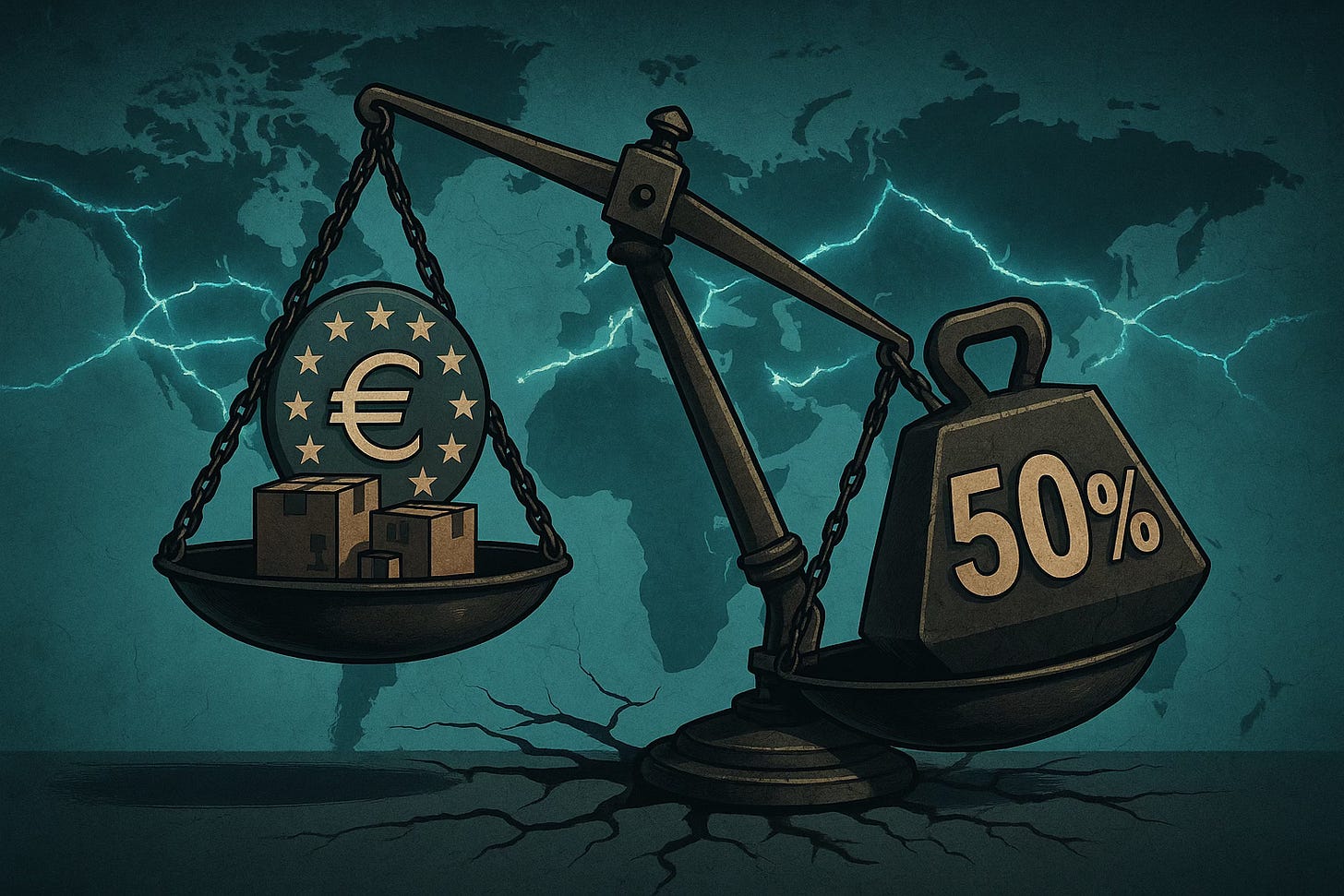Trade by Tantrum
50% tariffs on Europe. No strategy, no stability—just shock diplomacy at scale.
Well, here we go again.
Just when markets were starting to believe the second Trump term might be more “talk than tariff,” he jumps on Truth Social and casually threatens to slap a 50% import tax on every single thing coming in from Europe. Wine, cars, machinery—consider them all on the chopping block. Why? Because talks were “unproductive.” That’s it. No spreadsheet. No white paper. Just vibes and a very round number.
It’s not just a policy pivot—it’s a full-on economic grenade with a timer set for June 1. And if you’re wondering how we got here, you’re not alone. But this isn’t about clarity. It’s about chaos. And Trump seems to think chaos negotiates better than diplomats ever could.
Let’s rewind.
Back in April, Trump rolled out “Liberation Day”—a marketing masterstroke for what was essentially a 20% tariff blitzon EU goods. Then he pulled it back to 10% with a 90-day “pause,” giving trade talks a shot. Spoiler: not much happened.
Meanwhile, Apple got dragged into this circus. Trump publicly reminded Tim Cook that iPhones had better be made in the USA—or they’d be taxed like foreign luxury goods. Legal? Questionable. Intentional? Definitely. It was the clearest sign yet that this wasn’t just about Brussels. It was about dominance, headlines, and control.
Fast forward to May 23. Trump’s done waiting. Negotiations with the EU, he says, are “going nowhere.” So he pulls the pin: a straight 50% tariff on all EU imports starting June 1. No nuance. No wiggle room. Just a blunt force threat to one of America’s biggest trading partners.
Across the Atlantic, Brussels is doing the political equivalent of blinking slowly. European Commission President Ursula von der Leyen is trying to stay optimistic, floating words like “mutually beneficial agreements.” EU Trade Commissioner Maroš Šefčovič, on the other hand, sounds done with the show. After three rounds of talks with zero traction, he’s calling it what it is: stalled and one-sided.
But the EU isn’t just whining.
They’re gearing up for a $107 billion retaliation package—planes, soybeans, bourbon. Everything that hurts in swing states. They’re even dusting off the WTO rulebook, although let’s be honest, no one’s betting on that toothless tiger to bite.
In the meantime, the EU is busy making friends elsewhere. Japan. Canada. Anyone not threatening to upend $1.3 trillion in annual trade on a whim.
Let’s talk numbers.
A 50% tariff isn’t just big—it’s historic. It jacks up prices on German cars, Italian leather, French wine, and most things Americans like to buy when they’re pretending to be cultured. It could also hammer European exporters just as they’re climbing out of recession.
US farmers and manufacturers won’t be spared either. The EU’s counterpunch hits agricultural exports, planes, and whiskey. And yes, the euro slid on the news—because even forex traders know this might get uglier.
Then there’s the real economic boogeyman: stagflation.
Chicago Fed President Austan Goolsbee basically said what Wall Street was already thinking. A 50% tariff is not just a trade story—it’s a central bank nightmare. It raises costs, slows output, and fuels inflation. The holy trinity of “Oh no.”
So is there a plan here? Or just vibes?
Trump’s defenders say this is long overdue—reciprocity, strength, leverage. His critics say it’s erratic, dangerous, and borderline theatrical. What’s more likely is that it’s both. Strategic chaos. Escalate to de-escalate. Or maybe just escalate for the applause.
Some even whisper about market manipulation. That tariffs aren’t about trade, but about jolting markets, playing the narrative, and letting insiders surf the volatility. A bold claim—but not impossible in a world where perception moves more capital than fundamentals.
And the geopolitical cracks are widening.
Europeans are starting to act like they might not need Washington’s blessing anymore. From funding Radio Free Europethemselves to floating bans on Nord Stream as a preemptive strike on any Putin-Trump axis—Brussels is drawing its own red lines.
This isn’t just a trade war. It’s a symptom. Of something bigger. Of a fading alliance. Of a shift from cooperation to confrontation. And if the upcoming Greer–Šefčovič meeting doesn’t produce something meaningful, this could all spin further out of control.
But let’s not kid ourselves.
This was never just about tariffs—or even trade. It’s about leverage in a world where diplomacy is losing ground to performance. A 50% tariff is not a policy—it’s a signal. One that says: We make the rules now. Or we break them.
And Europe? It’s stuck between defending its economic dignity and avoiding full-blown escalation. The upcoming Greer–Šefčovič meeting may offer another round of polite statements—but don’t expect a handshake to fix what a hammer just shattered.
What’s unfolding isn’t negotiation. It’s recalibration. Of alliances. Of risk. Of global power itself.
And the bill? That’s still being written—in currencies, in inflation, in credibility.


